Application of Learning Theories in Education: An Essay
VerifiedAdded on 2022/07/29
|10
|2642
|27
Essay
AI Summary
This essay delves into the application of learning theories, specifically focusing on behaviorism and humanism. It explores the historical context and core principles of each theory, highlighting their impact on teaching practices and student learning. The essay examines the strengths and limitations of both behaviorism and humanism, providing examples of their practical application in educational settings. Furthermore, it discusses the theoretical, social, and educational contexts influencing the implementation of these theories, emphasizing the importance of understanding student needs and fostering effective communication in the classroom. The essay concludes by summarizing the contrasting approaches of behaviorism and humanism and their respective roles in shaping education, advocating for a balanced approach that considers both environmental influences and individual student needs to facilitate optimal learning outcomes.
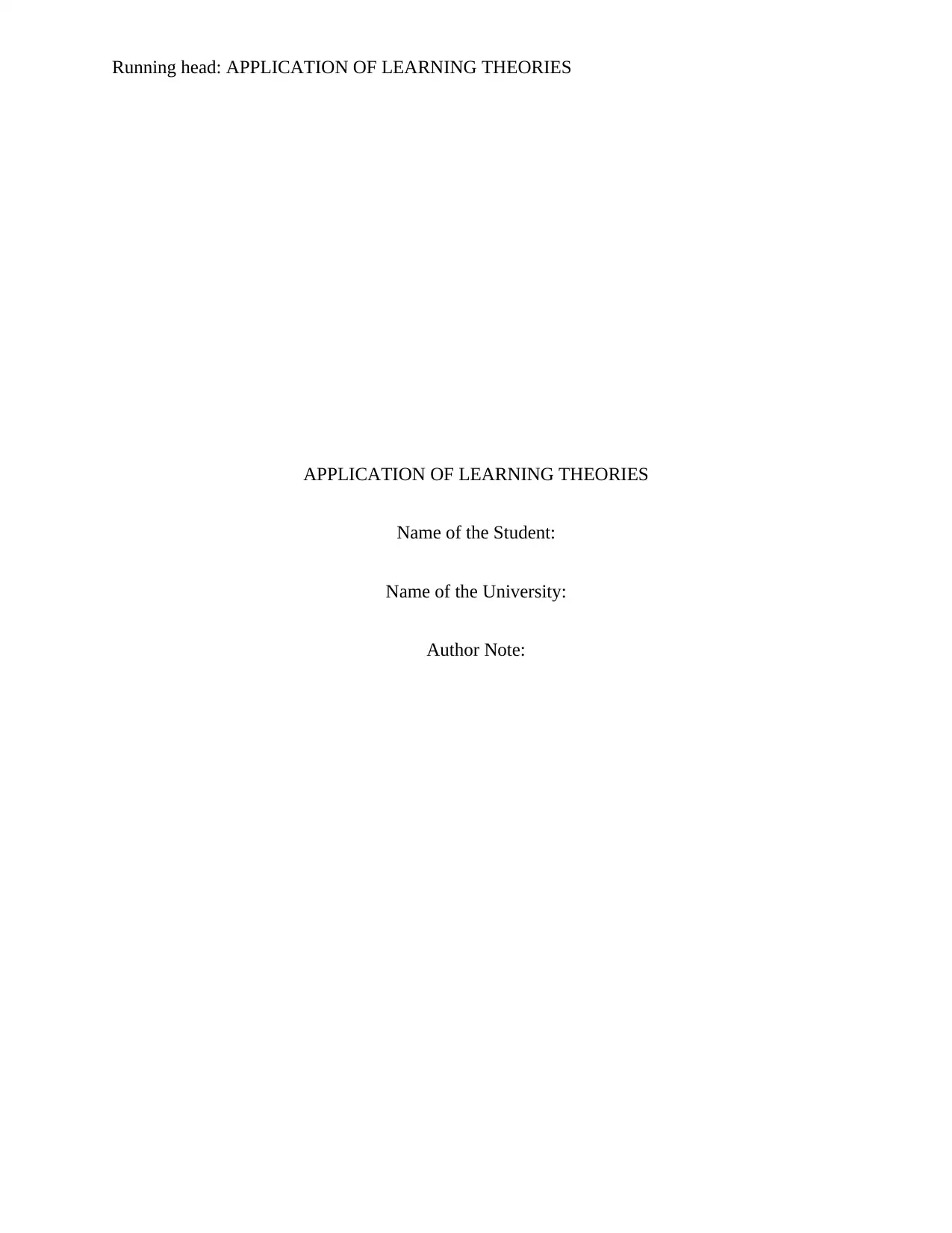
Running head: APPLICATION OF LEARNING THEORIES
APPLICATION OF LEARNING THEORIES
Name of the Student:
Name of the University:
Author Note:
APPLICATION OF LEARNING THEORIES
Name of the Student:
Name of the University:
Author Note:
Paraphrase This Document
Need a fresh take? Get an instant paraphrase of this document with our AI Paraphraser
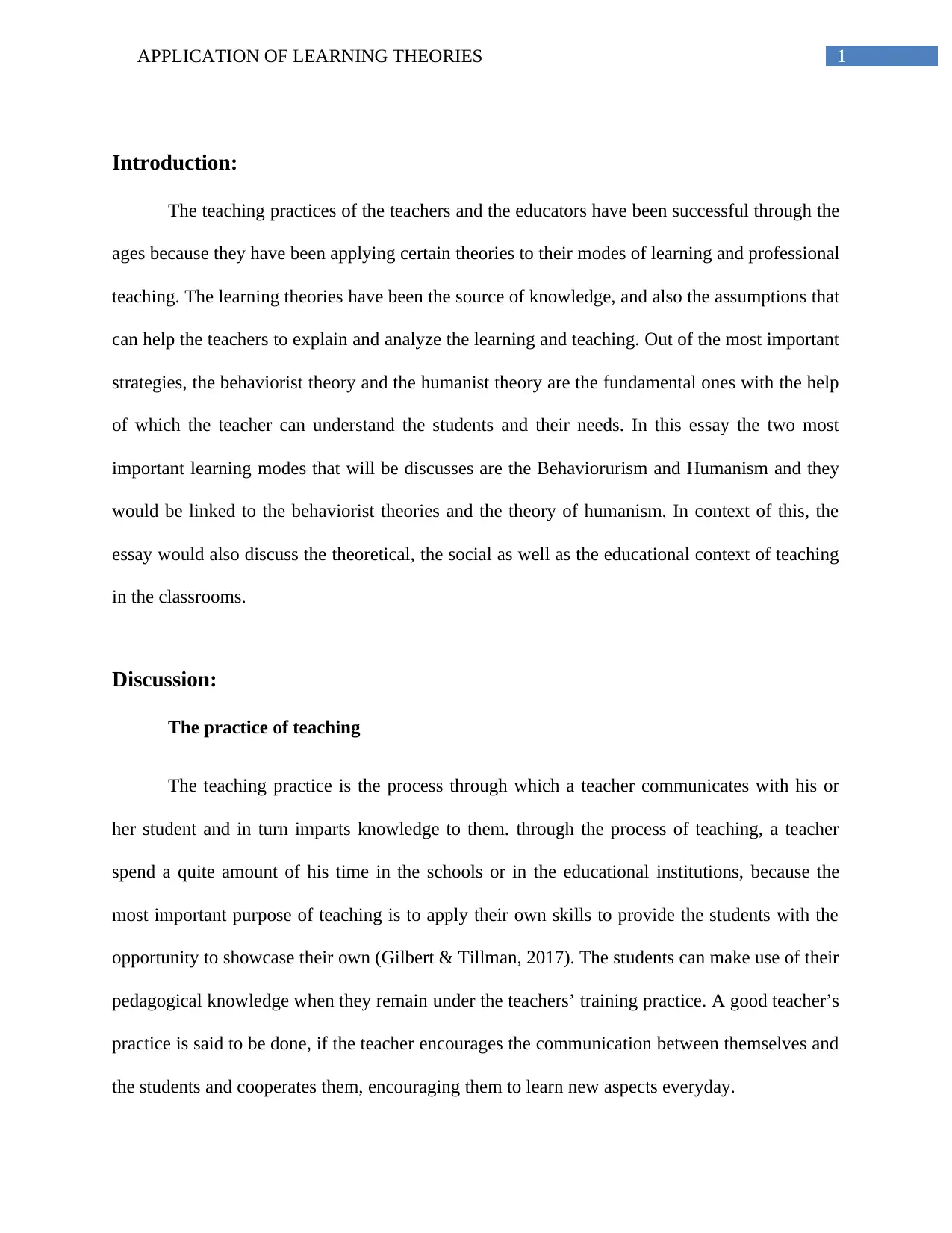
1APPLICATION OF LEARNING THEORIES
Introduction:
The teaching practices of the teachers and the educators have been successful through the
ages because they have been applying certain theories to their modes of learning and professional
teaching. The learning theories have been the source of knowledge, and also the assumptions that
can help the teachers to explain and analyze the learning and teaching. Out of the most important
strategies, the behaviorist theory and the humanist theory are the fundamental ones with the help
of which the teacher can understand the students and their needs. In this essay the two most
important learning modes that will be discusses are the Behaviorurism and Humanism and they
would be linked to the behaviorist theories and the theory of humanism. In context of this, the
essay would also discuss the theoretical, the social as well as the educational context of teaching
in the classrooms.
Discussion:
The practice of teaching
The teaching practice is the process through which a teacher communicates with his or
her student and in turn imparts knowledge to them. through the process of teaching, a teacher
spend a quite amount of his time in the schools or in the educational institutions, because the
most important purpose of teaching is to apply their own skills to provide the students with the
opportunity to showcase their own (Gilbert & Tillman, 2017). The students can make use of their
pedagogical knowledge when they remain under the teachers’ training practice. A good teacher’s
practice is said to be done, if the teacher encourages the communication between themselves and
the students and cooperates them, encouraging them to learn new aspects everyday.
Introduction:
The teaching practices of the teachers and the educators have been successful through the
ages because they have been applying certain theories to their modes of learning and professional
teaching. The learning theories have been the source of knowledge, and also the assumptions that
can help the teachers to explain and analyze the learning and teaching. Out of the most important
strategies, the behaviorist theory and the humanist theory are the fundamental ones with the help
of which the teacher can understand the students and their needs. In this essay the two most
important learning modes that will be discusses are the Behaviorurism and Humanism and they
would be linked to the behaviorist theories and the theory of humanism. In context of this, the
essay would also discuss the theoretical, the social as well as the educational context of teaching
in the classrooms.
Discussion:
The practice of teaching
The teaching practice is the process through which a teacher communicates with his or
her student and in turn imparts knowledge to them. through the process of teaching, a teacher
spend a quite amount of his time in the schools or in the educational institutions, because the
most important purpose of teaching is to apply their own skills to provide the students with the
opportunity to showcase their own (Gilbert & Tillman, 2017). The students can make use of their
pedagogical knowledge when they remain under the teachers’ training practice. A good teacher’s
practice is said to be done, if the teacher encourages the communication between themselves and
the students and cooperates them, encouraging them to learn new aspects everyday.
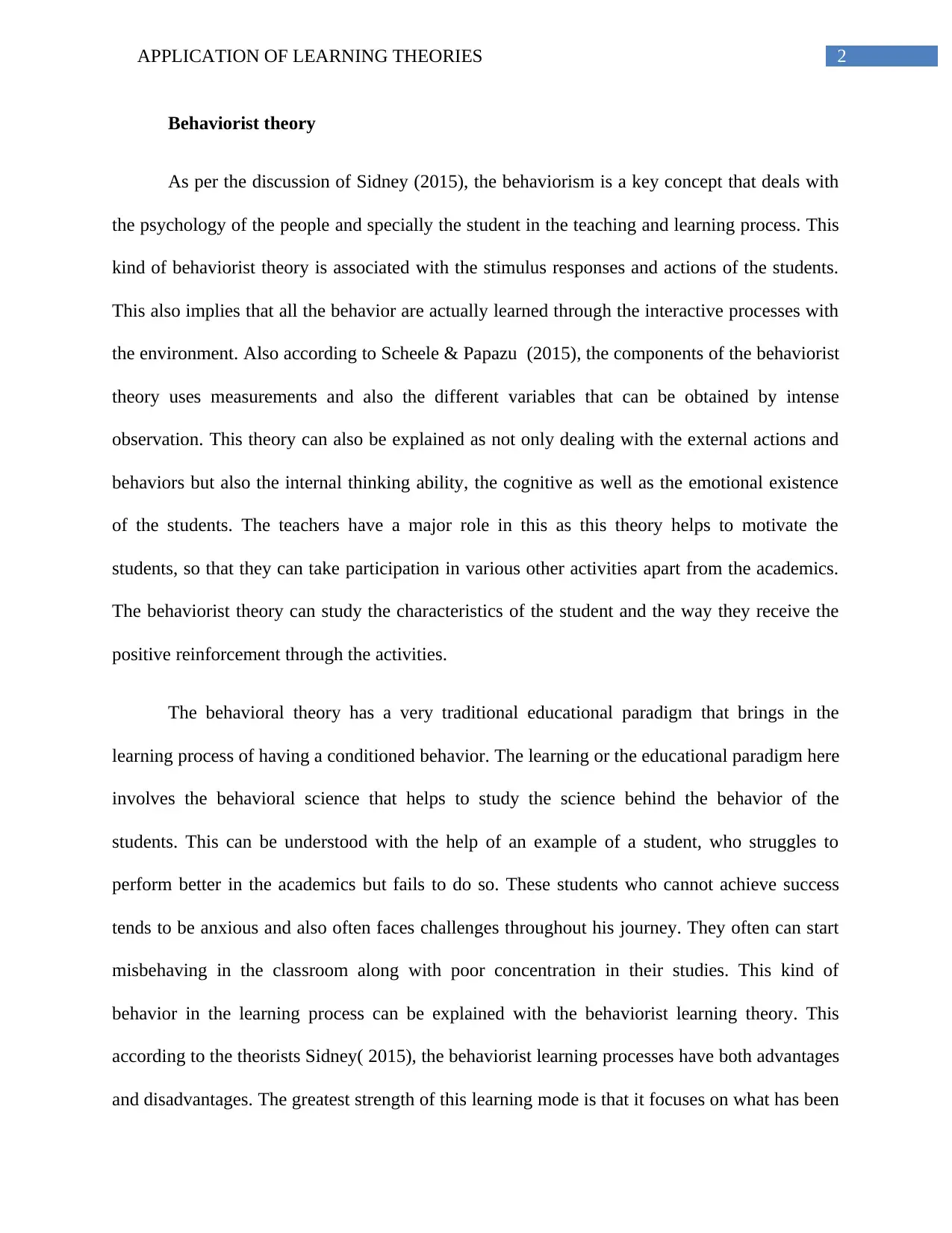
2APPLICATION OF LEARNING THEORIES
Behaviorist theory
As per the discussion of Sidney (2015), the behaviorism is a key concept that deals with
the psychology of the people and specially the student in the teaching and learning process. This
kind of behaviorist theory is associated with the stimulus responses and actions of the students.
This also implies that all the behavior are actually learned through the interactive processes with
the environment. Also according to Scheele & Papazu (2015), the components of the behaviorist
theory uses measurements and also the different variables that can be obtained by intense
observation. This theory can also be explained as not only dealing with the external actions and
behaviors but also the internal thinking ability, the cognitive as well as the emotional existence
of the students. The teachers have a major role in this as this theory helps to motivate the
students, so that they can take participation in various other activities apart from the academics.
The behaviorist theory can study the characteristics of the student and the way they receive the
positive reinforcement through the activities.
The behavioral theory has a very traditional educational paradigm that brings in the
learning process of having a conditioned behavior. The learning or the educational paradigm here
involves the behavioral science that helps to study the science behind the behavior of the
students. This can be understood with the help of an example of a student, who struggles to
perform better in the academics but fails to do so. These students who cannot achieve success
tends to be anxious and also often faces challenges throughout his journey. They often can start
misbehaving in the classroom along with poor concentration in their studies. This kind of
behavior in the learning process can be explained with the behaviorist learning theory. This
according to the theorists Sidney( 2015), the behaviorist learning processes have both advantages
and disadvantages. The greatest strength of this learning mode is that it focuses on what has been
Behaviorist theory
As per the discussion of Sidney (2015), the behaviorism is a key concept that deals with
the psychology of the people and specially the student in the teaching and learning process. This
kind of behaviorist theory is associated with the stimulus responses and actions of the students.
This also implies that all the behavior are actually learned through the interactive processes with
the environment. Also according to Scheele & Papazu (2015), the components of the behaviorist
theory uses measurements and also the different variables that can be obtained by intense
observation. This theory can also be explained as not only dealing with the external actions and
behaviors but also the internal thinking ability, the cognitive as well as the emotional existence
of the students. The teachers have a major role in this as this theory helps to motivate the
students, so that they can take participation in various other activities apart from the academics.
The behaviorist theory can study the characteristics of the student and the way they receive the
positive reinforcement through the activities.
The behavioral theory has a very traditional educational paradigm that brings in the
learning process of having a conditioned behavior. The learning or the educational paradigm here
involves the behavioral science that helps to study the science behind the behavior of the
students. This can be understood with the help of an example of a student, who struggles to
perform better in the academics but fails to do so. These students who cannot achieve success
tends to be anxious and also often faces challenges throughout his journey. They often can start
misbehaving in the classroom along with poor concentration in their studies. This kind of
behavior in the learning process can be explained with the behaviorist learning theory. This
according to the theorists Sidney( 2015), the behaviorist learning processes have both advantages
and disadvantages. The greatest strength of this learning mode is that it focuses on what has been
⊘ This is a preview!⊘
Do you want full access?
Subscribe today to unlock all pages.

Trusted by 1+ million students worldwide
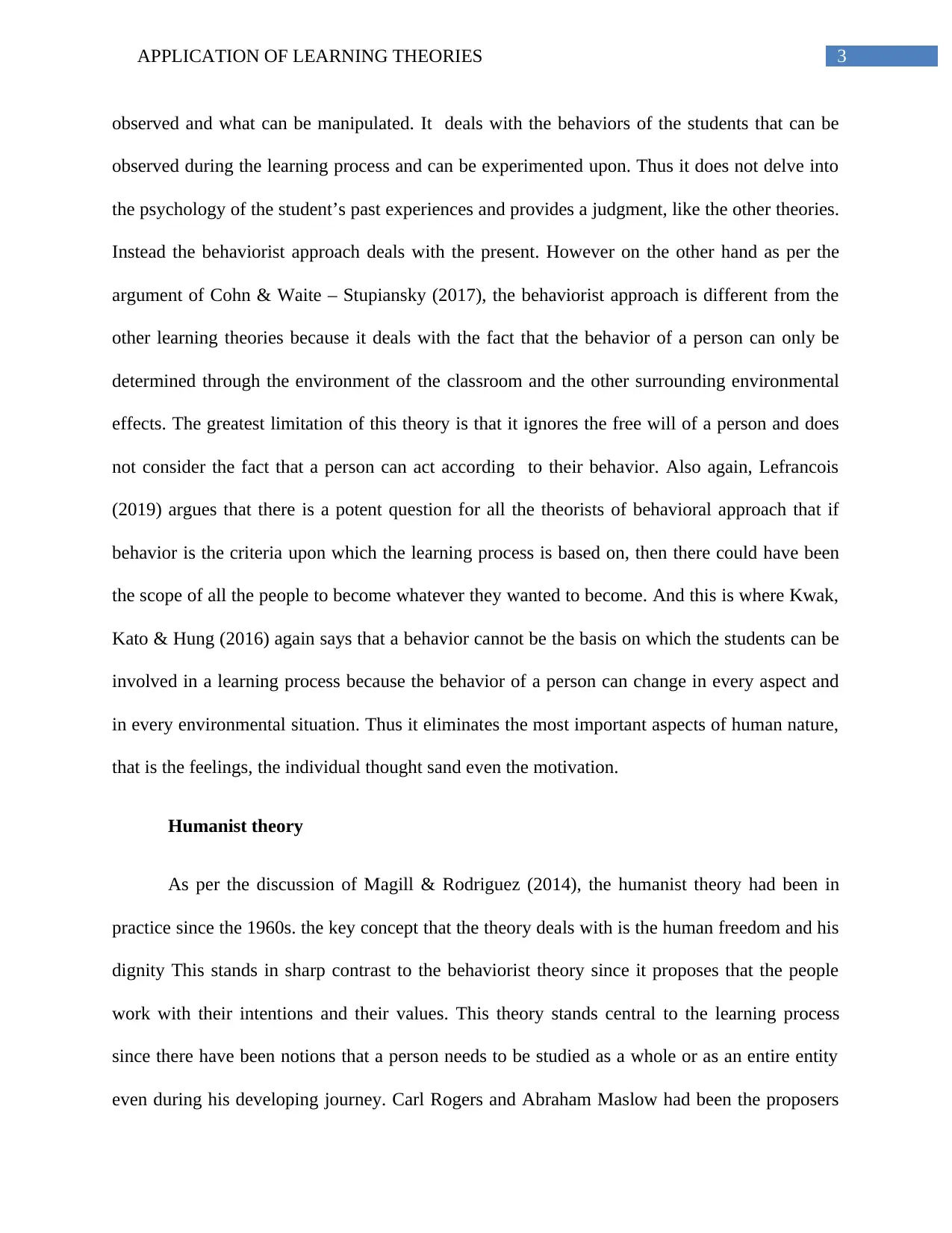
3APPLICATION OF LEARNING THEORIES
observed and what can be manipulated. It deals with the behaviors of the students that can be
observed during the learning process and can be experimented upon. Thus it does not delve into
the psychology of the student’s past experiences and provides a judgment, like the other theories.
Instead the behaviorist approach deals with the present. However on the other hand as per the
argument of Cohn & Waite – Stupiansky (2017), the behaviorist approach is different from the
other learning theories because it deals with the fact that the behavior of a person can only be
determined through the environment of the classroom and the other surrounding environmental
effects. The greatest limitation of this theory is that it ignores the free will of a person and does
not consider the fact that a person can act according to their behavior. Also again, Lefrancois
(2019) argues that there is a potent question for all the theorists of behavioral approach that if
behavior is the criteria upon which the learning process is based on, then there could have been
the scope of all the people to become whatever they wanted to become. And this is where Kwak,
Kato & Hung (2016) again says that a behavior cannot be the basis on which the students can be
involved in a learning process because the behavior of a person can change in every aspect and
in every environmental situation. Thus it eliminates the most important aspects of human nature,
that is the feelings, the individual thought sand even the motivation.
Humanist theory
As per the discussion of Magill & Rodriguez (2014), the humanist theory had been in
practice since the 1960s. the key concept that the theory deals with is the human freedom and his
dignity This stands in sharp contrast to the behaviorist theory since it proposes that the people
work with their intentions and their values. This theory stands central to the learning process
since there have been notions that a person needs to be studied as a whole or as an entire entity
even during his developing journey. Carl Rogers and Abraham Maslow had been the proposers
observed and what can be manipulated. It deals with the behaviors of the students that can be
observed during the learning process and can be experimented upon. Thus it does not delve into
the psychology of the student’s past experiences and provides a judgment, like the other theories.
Instead the behaviorist approach deals with the present. However on the other hand as per the
argument of Cohn & Waite – Stupiansky (2017), the behaviorist approach is different from the
other learning theories because it deals with the fact that the behavior of a person can only be
determined through the environment of the classroom and the other surrounding environmental
effects. The greatest limitation of this theory is that it ignores the free will of a person and does
not consider the fact that a person can act according to their behavior. Also again, Lefrancois
(2019) argues that there is a potent question for all the theorists of behavioral approach that if
behavior is the criteria upon which the learning process is based on, then there could have been
the scope of all the people to become whatever they wanted to become. And this is where Kwak,
Kato & Hung (2016) again says that a behavior cannot be the basis on which the students can be
involved in a learning process because the behavior of a person can change in every aspect and
in every environmental situation. Thus it eliminates the most important aspects of human nature,
that is the feelings, the individual thought sand even the motivation.
Humanist theory
As per the discussion of Magill & Rodriguez (2014), the humanist theory had been in
practice since the 1960s. the key concept that the theory deals with is the human freedom and his
dignity This stands in sharp contrast to the behaviorist theory since it proposes that the people
work with their intentions and their values. This theory stands central to the learning process
since there have been notions that a person needs to be studied as a whole or as an entire entity
even during his developing journey. Carl Rogers and Abraham Maslow had been the proposers
Paraphrase This Document
Need a fresh take? Get an instant paraphrase of this document with our AI Paraphraser
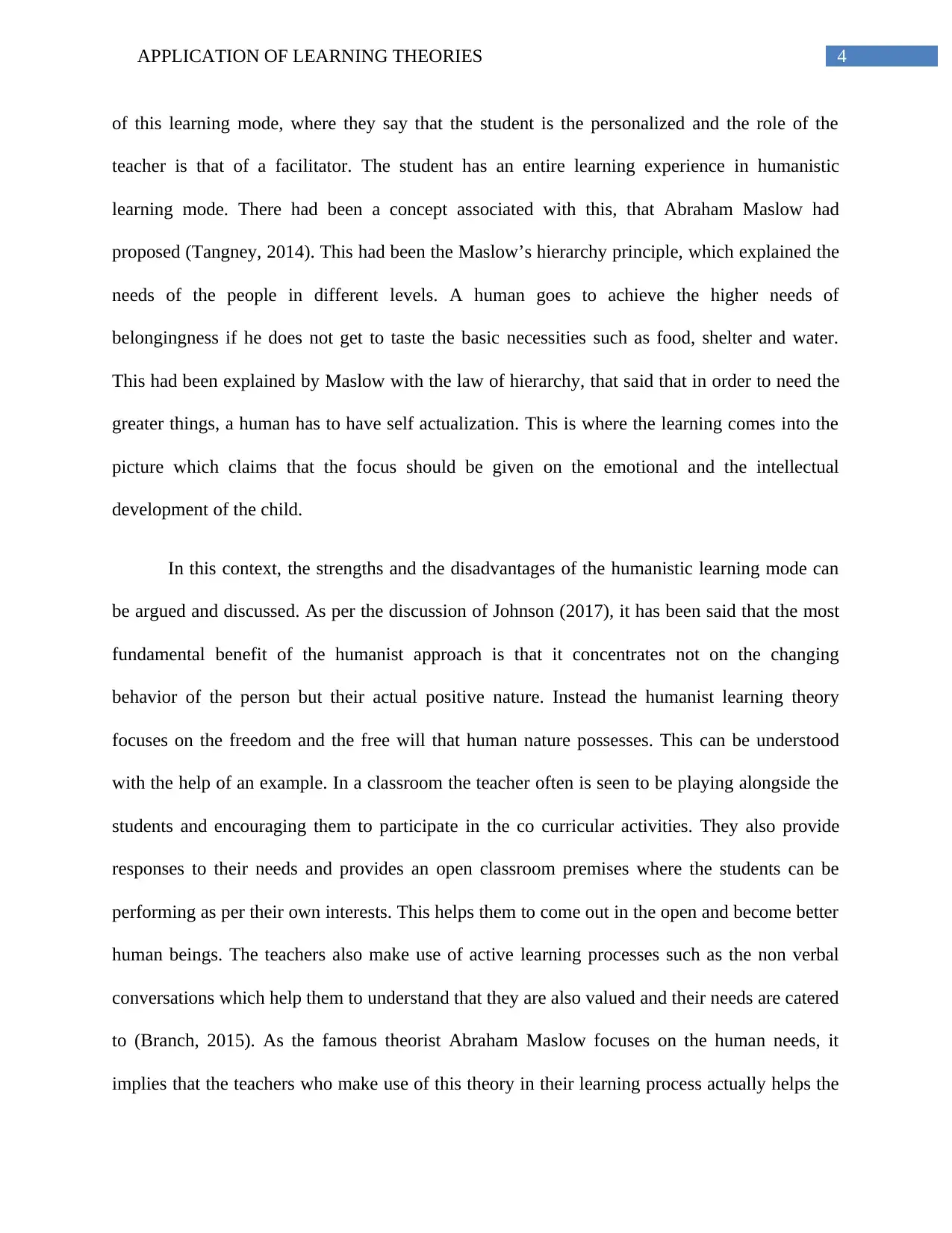
4APPLICATION OF LEARNING THEORIES
of this learning mode, where they say that the student is the personalized and the role of the
teacher is that of a facilitator. The student has an entire learning experience in humanistic
learning mode. There had been a concept associated with this, that Abraham Maslow had
proposed (Tangney, 2014). This had been the Maslow’s hierarchy principle, which explained the
needs of the people in different levels. A human goes to achieve the higher needs of
belongingness if he does not get to taste the basic necessities such as food, shelter and water.
This had been explained by Maslow with the law of hierarchy, that said that in order to need the
greater things, a human has to have self actualization. This is where the learning comes into the
picture which claims that the focus should be given on the emotional and the intellectual
development of the child.
In this context, the strengths and the disadvantages of the humanistic learning mode can
be argued and discussed. As per the discussion of Johnson (2017), it has been said that the most
fundamental benefit of the humanist approach is that it concentrates not on the changing
behavior of the person but their actual positive nature. Instead the humanist learning theory
focuses on the freedom and the free will that human nature possesses. This can be understood
with the help of an example. In a classroom the teacher often is seen to be playing alongside the
students and encouraging them to participate in the co curricular activities. They also provide
responses to their needs and provides an open classroom premises where the students can be
performing as per their own interests. This helps them to come out in the open and become better
human beings. The teachers also make use of active learning processes such as the non verbal
conversations which help them to understand that they are also valued and their needs are catered
to (Branch, 2015). As the famous theorist Abraham Maslow focuses on the human needs, it
implies that the teachers who make use of this theory in their learning process actually helps the
of this learning mode, where they say that the student is the personalized and the role of the
teacher is that of a facilitator. The student has an entire learning experience in humanistic
learning mode. There had been a concept associated with this, that Abraham Maslow had
proposed (Tangney, 2014). This had been the Maslow’s hierarchy principle, which explained the
needs of the people in different levels. A human goes to achieve the higher needs of
belongingness if he does not get to taste the basic necessities such as food, shelter and water.
This had been explained by Maslow with the law of hierarchy, that said that in order to need the
greater things, a human has to have self actualization. This is where the learning comes into the
picture which claims that the focus should be given on the emotional and the intellectual
development of the child.
In this context, the strengths and the disadvantages of the humanistic learning mode can
be argued and discussed. As per the discussion of Johnson (2017), it has been said that the most
fundamental benefit of the humanist approach is that it concentrates not on the changing
behavior of the person but their actual positive nature. Instead the humanist learning theory
focuses on the freedom and the free will that human nature possesses. This can be understood
with the help of an example. In a classroom the teacher often is seen to be playing alongside the
students and encouraging them to participate in the co curricular activities. They also provide
responses to their needs and provides an open classroom premises where the students can be
performing as per their own interests. This helps them to come out in the open and become better
human beings. The teachers also make use of active learning processes such as the non verbal
conversations which help them to understand that they are also valued and their needs are catered
to (Branch, 2015). As the famous theorist Abraham Maslow focuses on the human needs, it
implies that the teachers who make use of this theory in their learning process actually helps the
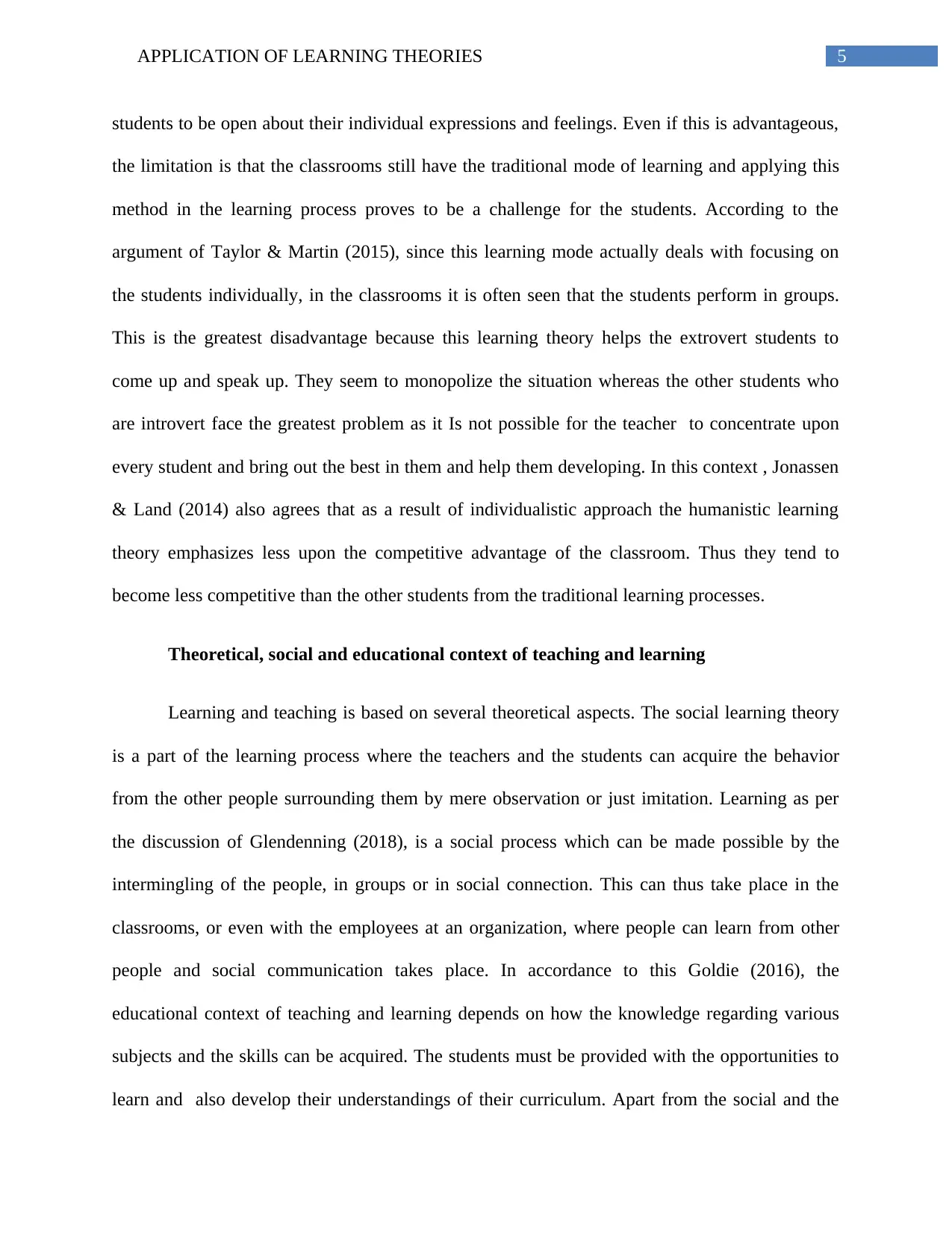
5APPLICATION OF LEARNING THEORIES
students to be open about their individual expressions and feelings. Even if this is advantageous,
the limitation is that the classrooms still have the traditional mode of learning and applying this
method in the learning process proves to be a challenge for the students. According to the
argument of Taylor & Martin (2015), since this learning mode actually deals with focusing on
the students individually, in the classrooms it is often seen that the students perform in groups.
This is the greatest disadvantage because this learning theory helps the extrovert students to
come up and speak up. They seem to monopolize the situation whereas the other students who
are introvert face the greatest problem as it Is not possible for the teacher to concentrate upon
every student and bring out the best in them and help them developing. In this context , Jonassen
& Land (2014) also agrees that as a result of individualistic approach the humanistic learning
theory emphasizes less upon the competitive advantage of the classroom. Thus they tend to
become less competitive than the other students from the traditional learning processes.
Theoretical, social and educational context of teaching and learning
Learning and teaching is based on several theoretical aspects. The social learning theory
is a part of the learning process where the teachers and the students can acquire the behavior
from the other people surrounding them by mere observation or just imitation. Learning as per
the discussion of Glendenning (2018), is a social process which can be made possible by the
intermingling of the people, in groups or in social connection. This can thus take place in the
classrooms, or even with the employees at an organization, where people can learn from other
people and social communication takes place. In accordance to this Goldie (2016), the
educational context of teaching and learning depends on how the knowledge regarding various
subjects and the skills can be acquired. The students must be provided with the opportunities to
learn and also develop their understandings of their curriculum. Apart from the social and the
students to be open about their individual expressions and feelings. Even if this is advantageous,
the limitation is that the classrooms still have the traditional mode of learning and applying this
method in the learning process proves to be a challenge for the students. According to the
argument of Taylor & Martin (2015), since this learning mode actually deals with focusing on
the students individually, in the classrooms it is often seen that the students perform in groups.
This is the greatest disadvantage because this learning theory helps the extrovert students to
come up and speak up. They seem to monopolize the situation whereas the other students who
are introvert face the greatest problem as it Is not possible for the teacher to concentrate upon
every student and bring out the best in them and help them developing. In this context , Jonassen
& Land (2014) also agrees that as a result of individualistic approach the humanistic learning
theory emphasizes less upon the competitive advantage of the classroom. Thus they tend to
become less competitive than the other students from the traditional learning processes.
Theoretical, social and educational context of teaching and learning
Learning and teaching is based on several theoretical aspects. The social learning theory
is a part of the learning process where the teachers and the students can acquire the behavior
from the other people surrounding them by mere observation or just imitation. Learning as per
the discussion of Glendenning (2018), is a social process which can be made possible by the
intermingling of the people, in groups or in social connection. This can thus take place in the
classrooms, or even with the employees at an organization, where people can learn from other
people and social communication takes place. In accordance to this Goldie (2016), the
educational context of teaching and learning depends on how the knowledge regarding various
subjects and the skills can be acquired. The students must be provided with the opportunities to
learn and also develop their understandings of their curriculum. Apart from the social and the
⊘ This is a preview!⊘
Do you want full access?
Subscribe today to unlock all pages.

Trusted by 1+ million students worldwide
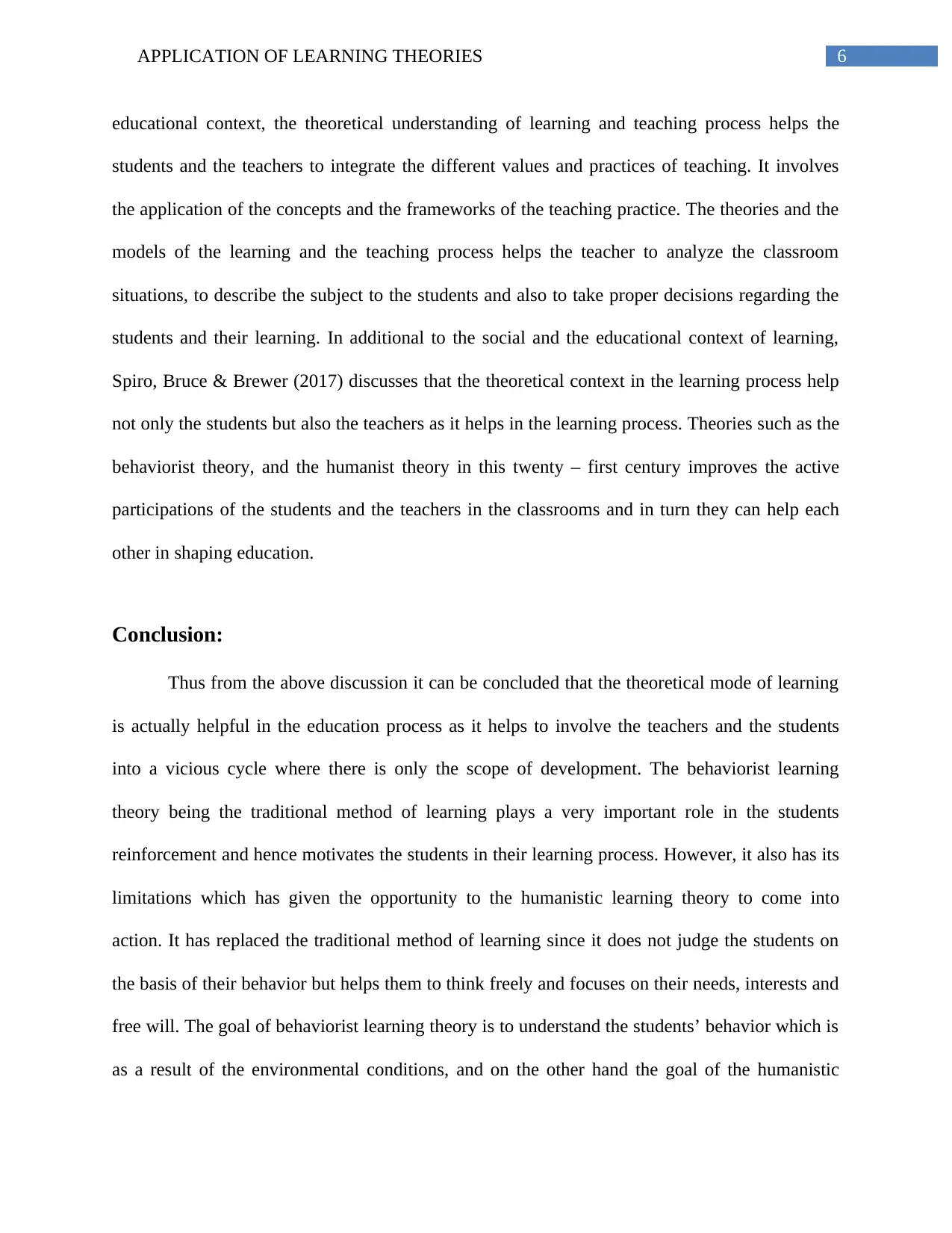
6APPLICATION OF LEARNING THEORIES
educational context, the theoretical understanding of learning and teaching process helps the
students and the teachers to integrate the different values and practices of teaching. It involves
the application of the concepts and the frameworks of the teaching practice. The theories and the
models of the learning and the teaching process helps the teacher to analyze the classroom
situations, to describe the subject to the students and also to take proper decisions regarding the
students and their learning. In additional to the social and the educational context of learning,
Spiro, Bruce & Brewer (2017) discusses that the theoretical context in the learning process help
not only the students but also the teachers as it helps in the learning process. Theories such as the
behaviorist theory, and the humanist theory in this twenty – first century improves the active
participations of the students and the teachers in the classrooms and in turn they can help each
other in shaping education.
Conclusion:
Thus from the above discussion it can be concluded that the theoretical mode of learning
is actually helpful in the education process as it helps to involve the teachers and the students
into a vicious cycle where there is only the scope of development. The behaviorist learning
theory being the traditional method of learning plays a very important role in the students
reinforcement and hence motivates the students in their learning process. However, it also has its
limitations which has given the opportunity to the humanistic learning theory to come into
action. It has replaced the traditional method of learning since it does not judge the students on
the basis of their behavior but helps them to think freely and focuses on their needs, interests and
free will. The goal of behaviorist learning theory is to understand the students’ behavior which is
as a result of the environmental conditions, and on the other hand the goal of the humanistic
educational context, the theoretical understanding of learning and teaching process helps the
students and the teachers to integrate the different values and practices of teaching. It involves
the application of the concepts and the frameworks of the teaching practice. The theories and the
models of the learning and the teaching process helps the teacher to analyze the classroom
situations, to describe the subject to the students and also to take proper decisions regarding the
students and their learning. In additional to the social and the educational context of learning,
Spiro, Bruce & Brewer (2017) discusses that the theoretical context in the learning process help
not only the students but also the teachers as it helps in the learning process. Theories such as the
behaviorist theory, and the humanist theory in this twenty – first century improves the active
participations of the students and the teachers in the classrooms and in turn they can help each
other in shaping education.
Conclusion:
Thus from the above discussion it can be concluded that the theoretical mode of learning
is actually helpful in the education process as it helps to involve the teachers and the students
into a vicious cycle where there is only the scope of development. The behaviorist learning
theory being the traditional method of learning plays a very important role in the students
reinforcement and hence motivates the students in their learning process. However, it also has its
limitations which has given the opportunity to the humanistic learning theory to come into
action. It has replaced the traditional method of learning since it does not judge the students on
the basis of their behavior but helps them to think freely and focuses on their needs, interests and
free will. The goal of behaviorist learning theory is to understand the students’ behavior which is
as a result of the environmental conditions, and on the other hand the goal of the humanistic
Paraphrase This Document
Need a fresh take? Get an instant paraphrase of this document with our AI Paraphraser
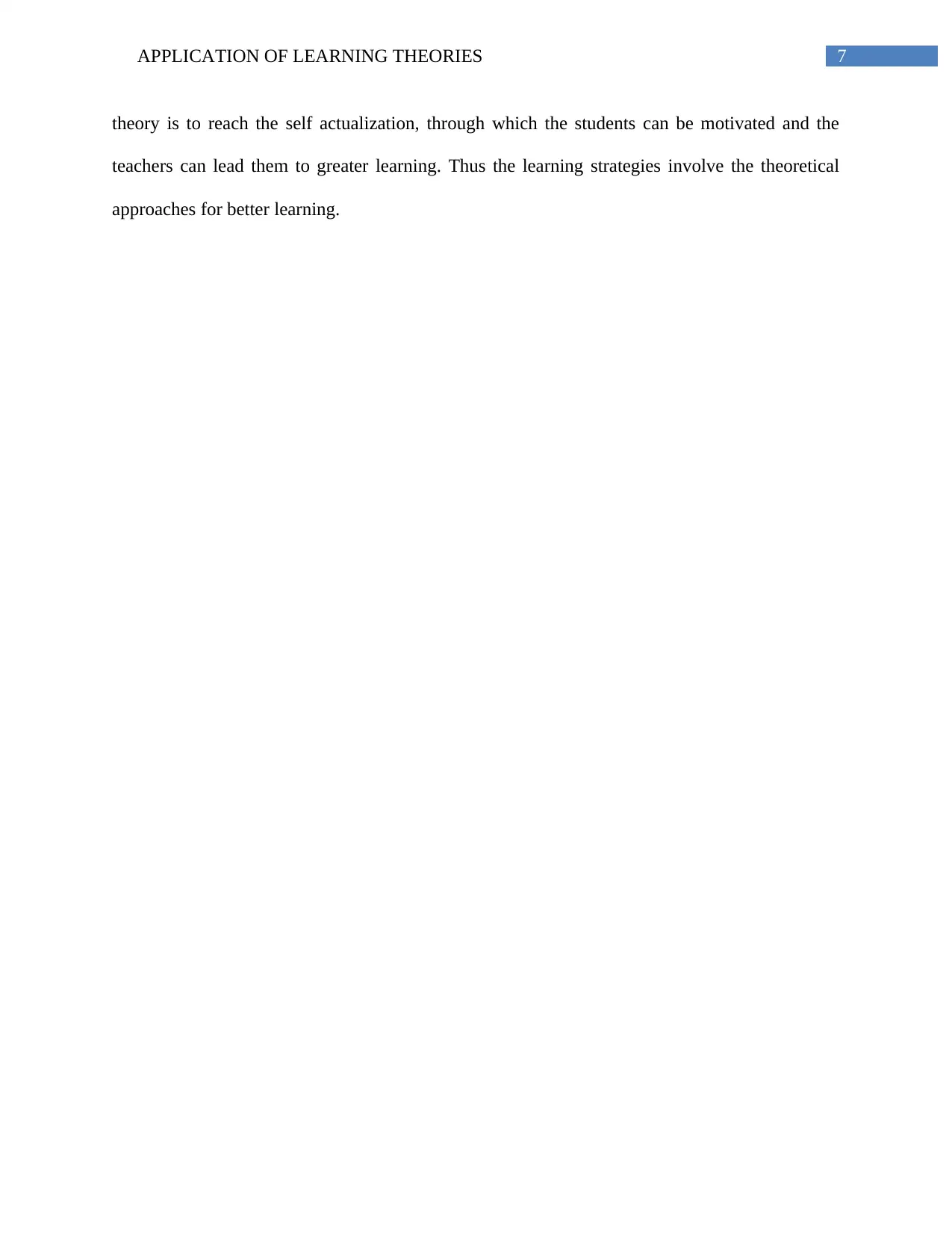
7APPLICATION OF LEARNING THEORIES
theory is to reach the self actualization, through which the students can be motivated and the
teachers can lead them to greater learning. Thus the learning strategies involve the theoretical
approaches for better learning.
theory is to reach the self actualization, through which the students can be motivated and the
teachers can lead them to greater learning. Thus the learning strategies involve the theoretical
approaches for better learning.
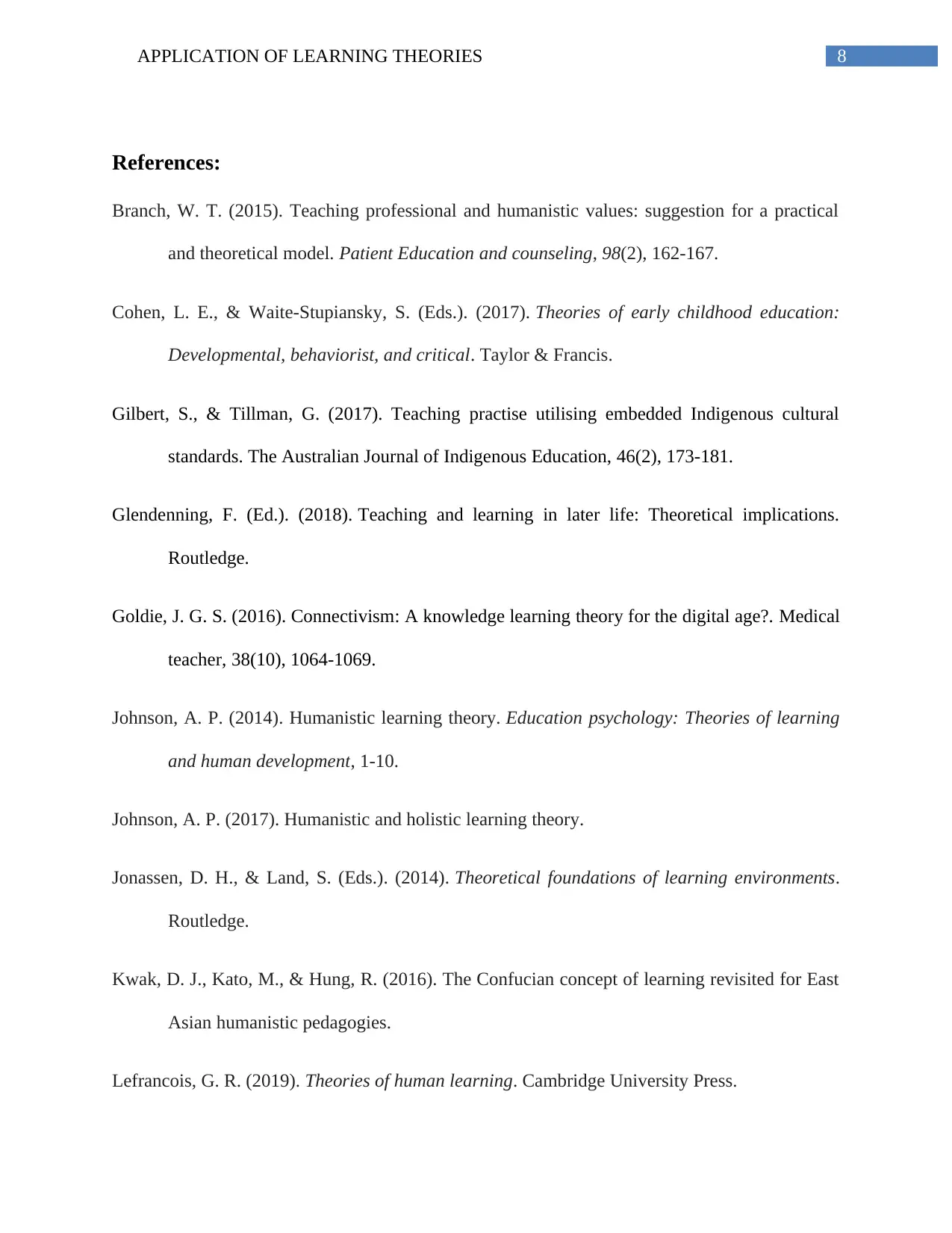
8APPLICATION OF LEARNING THEORIES
References:
Branch, W. T. (2015). Teaching professional and humanistic values: suggestion for a practical
and theoretical model. Patient Education and counseling, 98(2), 162-167.
Cohen, L. E., & Waite-Stupiansky, S. (Eds.). (2017). Theories of early childhood education:
Developmental, behaviorist, and critical. Taylor & Francis.
Gilbert, S., & Tillman, G. (2017). Teaching practise utilising embedded Indigenous cultural
standards. The Australian Journal of Indigenous Education, 46(2), 173-181.
Glendenning, F. (Ed.). (2018). Teaching and learning in later life: Theoretical implications.
Routledge.
Goldie, J. G. S. (2016). Connectivism: A knowledge learning theory for the digital age?. Medical
teacher, 38(10), 1064-1069.
Johnson, A. P. (2014). Humanistic learning theory. Education psychology: Theories of learning
and human development, 1-10.
Johnson, A. P. (2017). Humanistic and holistic learning theory.
Jonassen, D. H., & Land, S. (Eds.). (2014). Theoretical foundations of learning environments.
Routledge.
Kwak, D. J., Kato, M., & Hung, R. (2016). The Confucian concept of learning revisited for East
Asian humanistic pedagogies.
Lefrancois, G. R. (2019). Theories of human learning. Cambridge University Press.
References:
Branch, W. T. (2015). Teaching professional and humanistic values: suggestion for a practical
and theoretical model. Patient Education and counseling, 98(2), 162-167.
Cohen, L. E., & Waite-Stupiansky, S. (Eds.). (2017). Theories of early childhood education:
Developmental, behaviorist, and critical. Taylor & Francis.
Gilbert, S., & Tillman, G. (2017). Teaching practise utilising embedded Indigenous cultural
standards. The Australian Journal of Indigenous Education, 46(2), 173-181.
Glendenning, F. (Ed.). (2018). Teaching and learning in later life: Theoretical implications.
Routledge.
Goldie, J. G. S. (2016). Connectivism: A knowledge learning theory for the digital age?. Medical
teacher, 38(10), 1064-1069.
Johnson, A. P. (2014). Humanistic learning theory. Education psychology: Theories of learning
and human development, 1-10.
Johnson, A. P. (2017). Humanistic and holistic learning theory.
Jonassen, D. H., & Land, S. (Eds.). (2014). Theoretical foundations of learning environments.
Routledge.
Kwak, D. J., Kato, M., & Hung, R. (2016). The Confucian concept of learning revisited for East
Asian humanistic pedagogies.
Lefrancois, G. R. (2019). Theories of human learning. Cambridge University Press.
⊘ This is a preview!⊘
Do you want full access?
Subscribe today to unlock all pages.

Trusted by 1+ million students worldwide
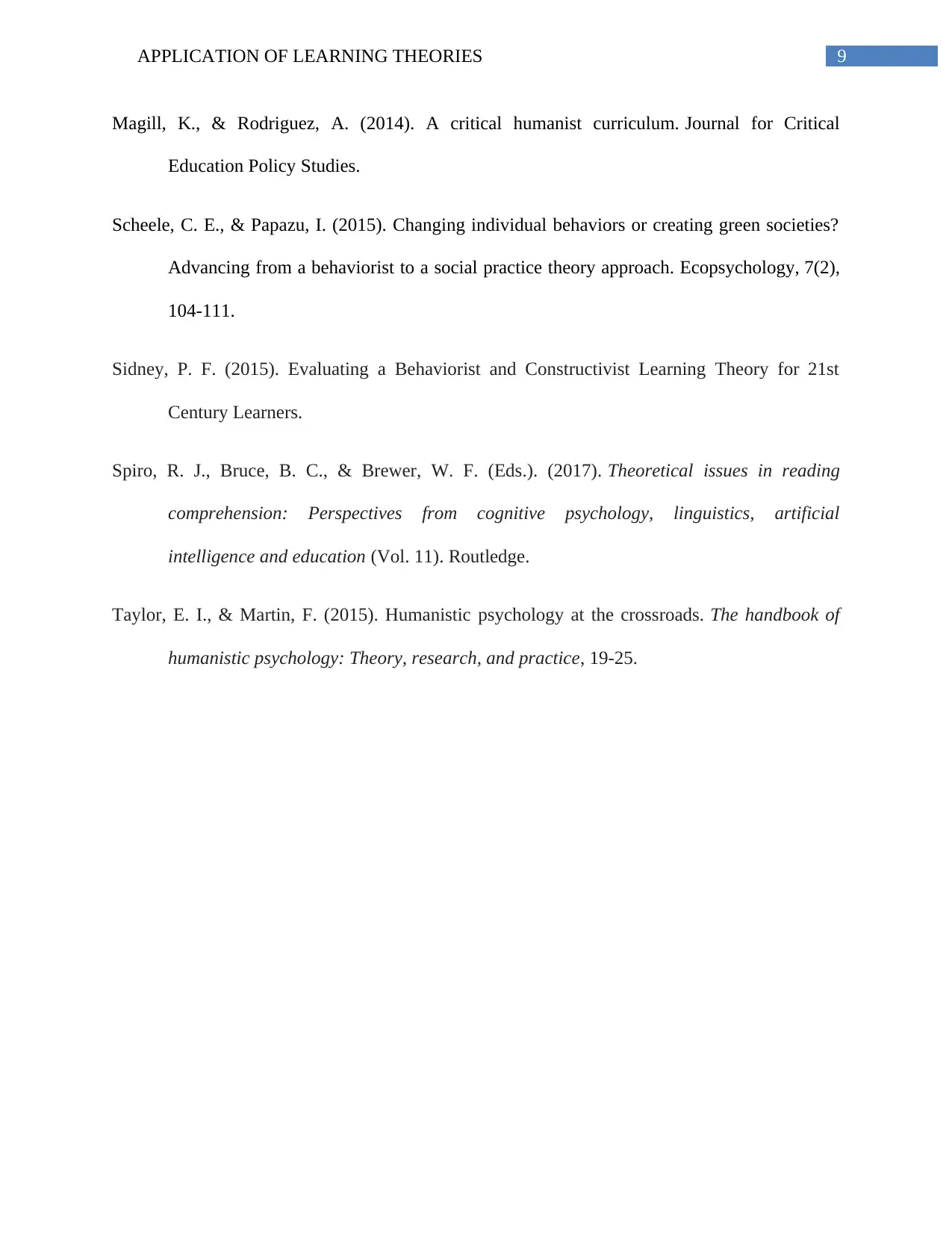
9APPLICATION OF LEARNING THEORIES
Magill, K., & Rodriguez, A. (2014). A critical humanist curriculum. Journal for Critical
Education Policy Studies.
Scheele, C. E., & Papazu, I. (2015). Changing individual behaviors or creating green societies?
Advancing from a behaviorist to a social practice theory approach. Ecopsychology, 7(2),
104-111.
Sidney, P. F. (2015). Evaluating a Behaviorist and Constructivist Learning Theory for 21st
Century Learners.
Spiro, R. J., Bruce, B. C., & Brewer, W. F. (Eds.). (2017). Theoretical issues in reading
comprehension: Perspectives from cognitive psychology, linguistics, artificial
intelligence and education (Vol. 11). Routledge.
Taylor, E. I., & Martin, F. (2015). Humanistic psychology at the crossroads. The handbook of
humanistic psychology: Theory, research, and practice, 19-25.
Magill, K., & Rodriguez, A. (2014). A critical humanist curriculum. Journal for Critical
Education Policy Studies.
Scheele, C. E., & Papazu, I. (2015). Changing individual behaviors or creating green societies?
Advancing from a behaviorist to a social practice theory approach. Ecopsychology, 7(2),
104-111.
Sidney, P. F. (2015). Evaluating a Behaviorist and Constructivist Learning Theory for 21st
Century Learners.
Spiro, R. J., Bruce, B. C., & Brewer, W. F. (Eds.). (2017). Theoretical issues in reading
comprehension: Perspectives from cognitive psychology, linguistics, artificial
intelligence and education (Vol. 11). Routledge.
Taylor, E. I., & Martin, F. (2015). Humanistic psychology at the crossroads. The handbook of
humanistic psychology: Theory, research, and practice, 19-25.
1 out of 10
Related Documents
Your All-in-One AI-Powered Toolkit for Academic Success.
+13062052269
info@desklib.com
Available 24*7 on WhatsApp / Email
![[object Object]](/_next/static/media/star-bottom.7253800d.svg)
Unlock your academic potential
Copyright © 2020–2025 A2Z Services. All Rights Reserved. Developed and managed by ZUCOL.





